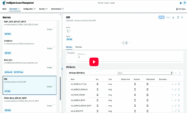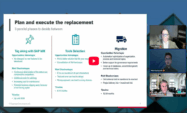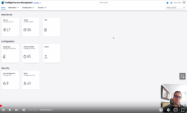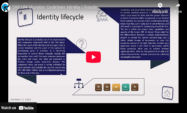SAP Identity Management
Filter By
Browse By
- SAP Analytics and AI
- SAP Application Development and Integration
- All SAP Application Development and Integration
- SAP ABAP
- SAP ABAP Development Tools
- SAP ABAP Test Cockpit
- SAP API Management
- SAP BAPI
- SAP Basis
- SAP BRF
- SAP Business Application Studio
- SAP CMS
- SAP Design Studio
- SAP Development Tools
- SAP DevOps
- SAP EAI
- SAP EDI
- SAP Extension Suite
- SAP Fiori
- SAP Fiori Elements
- SAP Integration Suite
- SAP Low Code Application Development
- SAP Low Code Automation
- SAP Netweaver
- SAP Release Management
- SAP UI5
- SAP Web Application Server
- SAP Web IDE
- SAP Business Process Management
- SAP Center of Excellence
- SAP CIO
- SAP Customer Experience
- SAP Data and Data Management
- All SAP Data and Data Management
- SAP BW
- SAP BW/4HANA
- SAP Crystal Reports
- SAP Data Archiving
- SAP Data Center
- SAP Data Governance
- SAP Data Integration
- SAP Data Migration
- SAP Data Quality
- SAP Data Services
- SAP Data Strategy
- SAP Data Visualization
- SAP Data Warehouse Cloud
- SAP DMS
- SAP Document Control
- SAP EIM
- SAP ETL
- SAP ETL Tools
- SAP HANA
- SAP HANA Administration
- SAP HANA Deployment Infrastructure
- SAP HANA Studio
- SAP Master Data
- SAP Master Data Governance
- SAP MDM
- SAP Enterprise Architect
- SAP Enterprise Asset Management
- SAP ERP
- SAP Finance
- All SAP Finance
- SAP Accounting
- SAP AR AP
- SAP Asset Accounting
- SAP Billing Systems
- SAP BPC
- SAP BRIM
- SAP Cash Management
- SAP Central Finance
- SAP Controlling
- SAP COPA
- SAP Cost Center Accounting
- SAP Currency Risk
- SAP e-invoicing
- SAP FICO
- SAP Finance Automation
- SAP Advanced Financial Closing
- SAP Financial Consolidation
- SAP Financial Planning
- SAP FX Risk
- SAP General Ledger
- SAP Global Tax Management
- SAP Hyperion
- SAP Order to Cash
- SAP Payment Processing
- SAP Profitability Analysis
- SAP Rebate Management
- SAP S/4HANA Finance
- SAP SWIFT Compliance
- SAP Treasury Management
- SAP Universal Journal
- SAP Governance Risk and Compliance
- SAP Human Capital Management
- SAP Intelligent Technologies
- SAP Platform and Technology
- All SAP Platform and Technology
- SAP Business Technology Platform
- SAP Cloud
- SAP Cloud Connector
- SAP Cloud Integration Platform
- SAP Cloud Migration
- SAP Cloud Platform
- SAP Cloud Providers
- SAP Cloud Strategy
- SAP Digital Signature
- SAP Container Platform
- SAP HANA Enterprise Cloud
- SAP Digital Asset Management
- SAP Smart Forms
- SAP HEC
- SAP Digital Integration Hub
- SAP Hyperscalers
- SAP Infrastructure
- SAP Messaging
- SAP Quality and Testing
- SAP Security
- SAP Spend Management
- SAP Supply Chain Management
- All SAP Supply Chain Management
- SAP APO
- SAP Asset Management
- SAP Business Network
- SAP Digital Manufacturing Cloud
- SAP Digital Twin
- SAP EWM
- SAP IBP
- SAP Inventory Management
- SAP Label Printing
- SAP Logistics
- SAP Manufacturing
- SAP Manufacturing Automation
- SAP MES
- SAP MII
- SAP MM
- SAP MRO
- SAP MRP
- SAP Order Management
- SAP Plant Maintenance
- SAP PLM
- SAP Production Planning
- SAP S&OP
- SAP SD
- SAP SPM
- SAP Supply Chain Planning
- SAP Track and Trace
- SAP Transportation Management
- SAP System Administration
What is SAP Identity Management?
With SAP Identity Management, organizations can perform identity provisioning, data synchronization, and identity virtualization. It enables organizations to embed identity management into their business processes and centralize user access management. The SAP Identity Management component helps organizations align user lifecycle management with key business processes running in cloud and on-premise. Business managers can define role-based user access rights and implement identity management across enterprise applications while providing centralized data, alerts, and reporting. The solution supports identity management across SAP software as well as heterogeneous and hybrid landscapes, including third-party business applications, operations systems, e-mail systems, and databases.
Key capabilities include:
- Line-of-business-driven identity management
- Built-in connector to cloud-based Identity Provisioning service
- Reporting and auditing functionality
- Password management and employee self-service
- Business-aligned user access rights, roles, and privileges
Key Considerations for SAPinsiders
What is SAP Identity Management?
With SAP Identity Management, organizations can perform identity provisioning, data synchronization, and identity virtualization. It enables organizations to embed identity management into their business processes and centralize user access management. The SAP Identity Management component helps organizations align user lifecycle management with key business processes running in cloud and on-premise. Business managers can define role-based user access rights and implement identity management across enterprise applications while providing centralized data, alerts, and reporting. The solution supports identity management across SAP software as well as heterogeneous and hybrid landscapes, including third-party business applications, operations systems, e-mail systems, and databases.
Key capabilities include:
- Line-of-business-driven identity management
- Built-in connector to cloud-based Identity Provisioning service
- Reporting and auditing functionality
- Password management and employee self-service
- Business-aligned user access rights, roles, and privileges
Key Considerations for SAPinsiders
Centralize identity management across applications and platforms. According to SAPinsider’s User Access and Identity Management for SAP S/4HANA benchmark report, a top goal for SAPinsider members is to centralize user access and identity management. Members are particularly worried about the proliferation of access points from the use of cloud-based apps. By centralizing identity management, SAP customers can improve security for cloud-based apps, reduce fraud, increase productivity, and speed up role setup, the report found. A centralized platform enables the organization to manage users of SAP and third-party applications in one place.
Shift identity management responsibilities from IT to lines of business. Putting password management, self-service portals, and workflow approvals in the hands of line-of-business managers improves productivity and security and reduces costs while freeing up IT to focus on more pressing issues. Business managers are also better at aligning roles and privileges with business processes rather than technical directory structures. They can quickly provision employees and business partners and make changes to access rights and privileges in a timely manner.
Integrate identity management with GRC to improve compliance with regulatory and audit requirements. In the previously cited benchmark report, SAPinsider members said that increasing government regulations were a driver for updating their organization’s identity management processes. By integrating identity management and GRC, multiple groups within the organization become involved in identity management. More departments with a stake mean that identity management gets a higher priority and more money within the organization, leading to improved processes and compliance. In addition, tighter integration enables mitigation of segregation-of-duties risks and a compliant user-provisioning process.
27 results
-

SAP IdM Migration Guidelines Announcement
ROIABLE is a provider of SAP expertise in the areas of User access and Workflow automation. Its own intelligent access management tool ROI iAM is the best alternative for former SAP IDM customers.
-

ROI iAM: a deeper look
ROI iAM is the best intelligent access management tool for companies with a big SAP landscape, especially former SAP IDM customers.
-

How to elevate your enterprise with intelligent Access Management
The answers are provided in the latest webinar by Todor Petrov from ROIABLE, Bo Baade-Pedersen from SAP and Nitish Deshpande from KuppingerCole Analysts.
-
-

ROI iAM: Migration of SAP IdM packages
ROI iAM is the best intelligent access management tool for companies with a big SAP landscape.
-

SAP IdM Migration Guidelines: Identity Lifecycle
ROIABLE is a provider of SAP expertise in the areas of User access and Workflow automation. Its own intelligent access management tool ROI iAM is the best alternative for former SAP IDM customers.
-

Saviynt University Takes Aim at the SAP Security Skills Gap
Reading time: 2 mins
Saviynt has launched a global Partner Delivery Excellence Program and Saviynt University to enhance identity security implementation quality and workforce skills, addressing the industry’s growing demand for trained identity governance professionals.
-

- SAP Identity Management
 Premium
Premium
SAP IDM Is Ending—Are You Ready for the Future of Identity Management?
Reading time: 5 mins
The end of SAP Identity Management (IDM) is looming, and it’s not just another "turn it off and on again" moment. With mainstream support wrapping up by 2027, this is a wake-up call. But don’t worry—it’s not all doom and gloom! In this article, I walk you through how to assess your current setup, preserve…
-
-

Efficient Optimization for License Management with Xiting
Reading time: 2 mins
SAP S/4HANA has transformed license management from transaction-based to user-determined permissions, complicating the process with new metrics and compliance needs, which necessitates continuous tracking and a clear authorization strategy, potentially aided by Xiting’s Authorizations Management Suite (XAMS) that offers tools like the Role Profiler and Role Designer for efficient license management.
-

Turnkey leads the way in delivering SAP Cloud Identity Access Governance (IAG)
Reading time: 1 mins
Turnkey’s customer is one of the largest soft drink bottlers in the Middle East, responsible for both manufacture and distribution. But, the complexity of managing around 50 locations and maintaining effective security controls and user access authorisations was becoming increasingly challenging.
-

Creating a Roadmap to Best Practice Identity and Access Management for Multinational Retailer – Case Study
Reading time: 1 mins
The complexity of managing large numbers of locations and employees while maintaining effective security controls, identity theft, and user access authorisations is a constant challenge.
Become a Member
Unlimited access to thousands of resources for SAP-specific expertise that can only be found here.
Become a Partner
Access exclusive SAP insights, expert marketing strategies, and high-value services including research reports, webinars, and buyers' guides, all designed to boost your campaign ROI by up to 50% within the SAP ecosystem.
Upcoming Events
Related Vendors
Your request has been successfully sent


